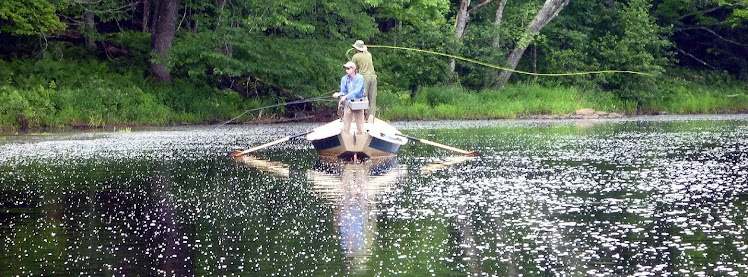The ‘hole’ was actually a span of riffles located next to a seam of slow-moving pocket water abutting the bank. Following a couple of roll casts, I casted traditionally, aiming near the edge of the pocket. With more line out, my soft hackle nymph drifted out along the slow water & began to swing across & into the riffles. Just as I began to strip line in, FISH ON! The temps were cold enough to freeze water on the rod guides, it was windy, & my soul was lifted. The fish fought well, leaping from the cloudy water. It was a 14” Rainbow; a feisty stocker. It was landed on Swiss Valley stream on my last hole of the day. Jackfish Kate and I had started out fishing together, but our paths split when Jackfish headed downstream, fishing and exploring. Soon after, I'd discovered a nice view of the stream when trekking along an uphill trail. Jackfish was framed beautifully while fishing in mixed ribbons of golden brown earth & milky brown water. We met back on the trail, readying for home. That was how we ended the day of March 12, 2011 in the NE Iowa Driftless region: fly fishing.
We started our day walking into the Swiss Valley Nature Center, Peosta, IA., just as the programs hosted by the Dubuque Fly Fishers and presented by Tight Lines Fly Shop owner Tim Landwehr and shop guide Nate Sipple were set to begin. Forty to fifty guests had come to listen to the men from the De Pere, WI, fly shop give their presentations. Topics included: how and where to fish for river Smallmouth Bass; demonstrations on how to tie smallie flies; and why the Midwest, and especially Wisconsin, is a fantastic & underappreciated freshwater fishery for fly anglers.
Of course Tim gave an overview of the offerings of his fly shop, including guide services with the 7 guides on staff, free winter programs of guest fly tiers, a large selection of flies for sale & the shop’s websites. He then delved into the meat of the first topic, which was how to successfully fish for river Smallmouth Bass. While standing in the heart of Iowa trout country, Tim reminded the anglers that trout live and interact differently in their habitat than smallies do in their habitat; therefore each species should be approached differently. For example: prey in the trout environment often move slowly whereas forage for smallies often move quickly & are generally chased; trout typically face into the current, but smallies face many directions; and trout hold close to, or in direct current, but river smallies prefer to hold in little or no current.
Then, with photos displaying on the video screen of river structure, interspersed with photos of happy clients with rotund 19”+ smallies, Tim provided examples of how to fish the given structure, the forage type & how it presents itself, and followed with how & when to fish top water, intermediate and sinking flies. Tim stated that 85-90% of a smallie’s diet is crayfish yet 2 of the most successful shop patterns used are the Bart-O and Mudich Minnows. Tim said, “Opportunity trumps quantity always”. More energy and risk are involved with eating a crayfish than a baitfish. Due to the aggressive nature of smallies, Tim also reminded the anglers not to cast in the same spot twice.
Nate presented the 2nd portion of the program. He demonstrated how to tie the Murdich Minnow & another un-named baitfish imitation he’d created. Additional tips, such as how & why to use an adhesive gel vs. the liquid version when attaching eyes, and why one should gently lift a fly tied with ‘Fish Lips’ to the water’s surface prior to casting again, were provided. The shop’s top 6 fly recommendations were given, and Tim gave a demo on how to tie a Fordyce Loop when attaching a fly, especially a popper or streamer pattern, such as a Clouser, to the leader.
 Tim finished the programs emphasizing how the Midwest & particularly Wisconsin is a great freshwater fishery for fly anglers. He spoke of stream improvements in NE IA and SW WI, the amount of free public access granted in these states & the diversity of fishing opportunities afforded those lucky enough to regularly fish the region. Tim claims the Midwest has the best Smallmouth Bass fishing available. He also spoke of trout streams, the Hexagenia Limbata hatches, the Musky Capital of the World, migratory fish including big Brown Trout and Steelhead, & of the hard-fighting carp.
Tim finished the programs emphasizing how the Midwest & particularly Wisconsin is a great freshwater fishery for fly anglers. He spoke of stream improvements in NE IA and SW WI, the amount of free public access granted in these states & the diversity of fishing opportunities afforded those lucky enough to regularly fish the region. Tim claims the Midwest has the best Smallmouth Bass fishing available. He also spoke of trout streams, the Hexagenia Limbata hatches, the Musky Capital of the World, migratory fish including big Brown Trout and Steelhead, & of the hard-fighting carp. Tim also displayed a graph comparing the length of the fishing seasons in Montana versus the Midwest. Shortly afterward, Jackfish and I donned our waders. The program was over but we had more Iowa winter fly fishing to do!
